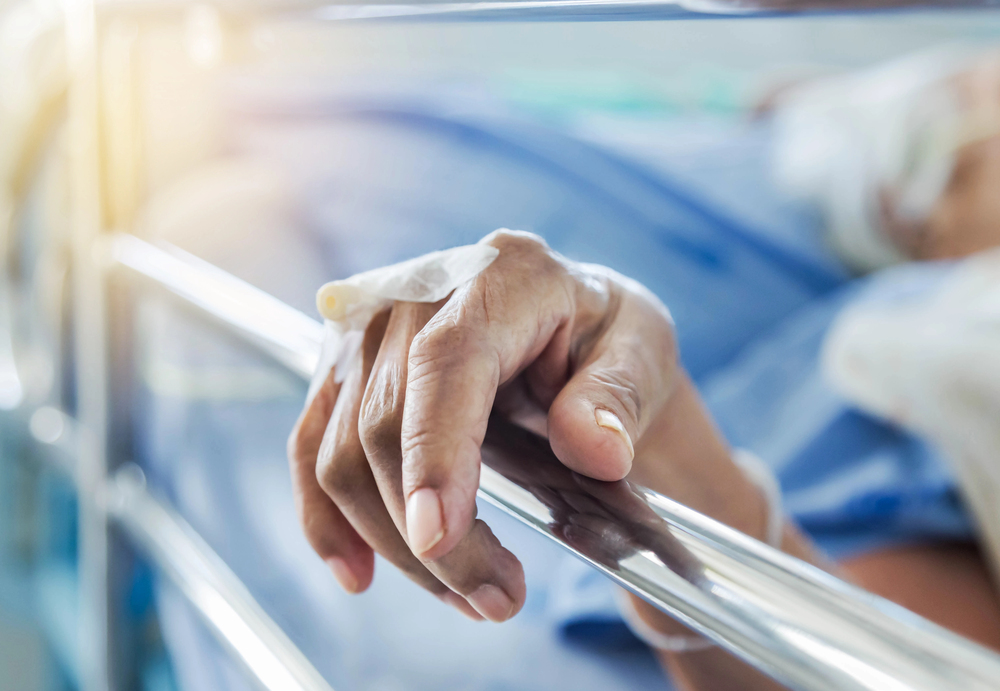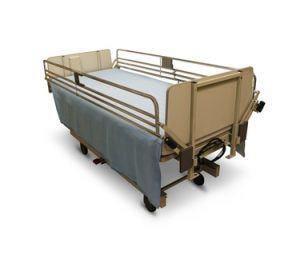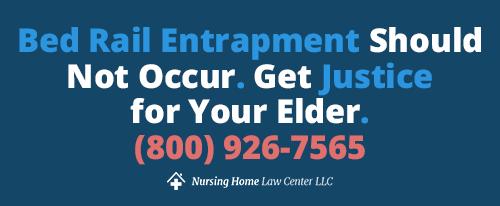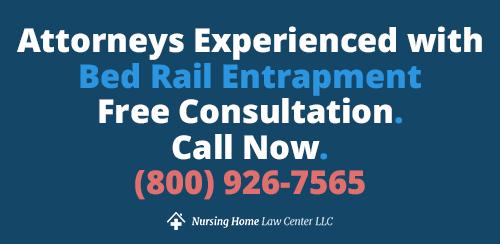The Nursing Home Law Center is committed to providing the legal resources necessary to hold negligent facilities accountable.
The Dangers of Bed Rails in Nursing Homes
Helping Victims of Nursing Home Bed Rail Injuries Recover Compensation
Families trust nursing homes to provide a safe environment, but inadequate supervision and improper use of bed rails can result in devastating consequences. If your loved one has suffered harm due to bed rail injuries in a nursing home, you may have legal options. A nursing home injury lawyer can help you hold negligent facilities accountable and seek justice for your family.
At Nursing Home Law Center, we have handled many cases of devastating losses caused by negligence in long-term care facilities. Example cases include:
- $3,000,000 settlement for the family of a resident admitted for short-term rehabilitation. Due to severe neglect, the individual suffered life-threatening complications that ultimately led to their passing.
- $2,333,000 settlement awarded after a facility failed to prevent serious abuse, leading to fatal consequences. The lack of oversight and failure to act allowed repeated harm to occur.
- $2,150,000 settlement obtained for a family whose loved one developed serious medical complications due to inadequate care. The facility’s failure to provide timely treatment led to an avoidable and tragic outcome.

Statistics on the Misuse of Bed Rails
Between 1985 and January 1, 2009, the U.S. Food and Drug Administration (FDA) received reports of 803 incidents where patients were caught, trapped, entangled, or strangled in nursing home or hospital beds with rails. Of these incidents, 480 resulted in death, 138 in non-fatal injuries, and 185 in no injuries due to staff intervention.
A study reviewing deaths related to bed rails found that 70% of fatalities were due to entrapment between the mattress and the rail, causing the individual’s face to be pressed against the mattress. An additional 18% involved entrapment and compression of the neck within the rails.
Since 2021, the Consumer Product Safety Commission (CPSC) has reported 18 deaths associated with adult portable bed rails. In response, there have been nine recalls affecting over 3 million units due to risks of entrapment and asphyxiation.
CPSC data indicates that 90% of injuries related to adult portable bed rails are due to entrapment of the head, chest, or neck.
The Purpose of Bed Rails in Nursing Homes
Bed rails, also known as side rails or safety rails, are metal or plastic barriers attached to the sides of a bed. Bed rails can be full-length, covering the entire side of a bed, or half-length, allowing for easier access while still offering some level of protection.
Some of the key reasons for their use In nursing homes and other long-term care facilities include:
- Fall prevention
- Mobility assistance, allowing residents to adjust their position or pull themselves up more easily.
- Security and comfort for some residents by offering a sense of enclosure and preventing unintended movement during sleep.
- Part of a medical care plan related to conditions such as Parkinson’s disease, stroke recovery, or spinal injuries.
The Risks Associated with Bed Rail Use in Nursing Facilities
Common risks and bed rail related injuries sustained in nursing homes include:
- Entrapment and Suffocation – A resident’s head, neck, or chest can become trapped between the rail and the mattress, restricting airflow and leading to asphyxiation or death.
- Strangulation and Internal Injuries – Loose clothing, medical tubing, or body parts can become caught in the rail, leading to severe trauma, restricted breathing, or internal injuries.
- Fractures and Skin Injuries – Residents may get their arms, legs, fingers, or heads caught in the rails, resulting in broken bones, severe bruising, or skin tears—especially in elderly individuals with fragile skin.
- Increased Fall Risk – Some residents, especially those with dementia or cognitive impairments, may attempt to climb over bed rails, leading to dangerous falls from greater heights, and increasing the risk of head injuries, spinal damage, or fractures.
- Psychological Distress – Residents may feel trapped, anxious, or agitated, leading to increased confusion, panic, or aggressive behavior, which can further put them at risk of harm.
- Delayed Emergency Response – When residents become trapped, a lack of staff supervision can delay intervention, turning a minor incident into a life-threatening emergency.
- Loss of Mobility and Independence – Prolonged use of bed rails can lead to muscle weakness and restricted movement, making residents more dependent on assistance and increasing overall health risks.

What Makes Bed Rails Dangerous to Nursing Home Residents
Though intended for safety, bed rails often pose more risks than benefits, especially when used without proper oversight.
- Misuse as a Physical Restraint – Some facilities use bed rails to restrict movement, causing agitation, panic, and self-injury, particularly in residents with dementia.
- Lack of Monitoring – Without proper supervision, entrapment, falls, and medical emergencies can go unnoticed.
- False Sense of Security – Families may assume bed rails enhance safety, but poor maintenance and misuse can increase injury risks.
The Legal Status of Bed Rail Use in Nursing Homes
Bed rails are not illegal, but their use in nursing homes is strictly regulated due to the risks they pose. Federal laws allow bed rails to be used only when necessary, and facilities must take specific precautions to ensure resident safety.
Regulations & Guidelines
Per 42 CFR §483.25(n), nursing facilities must:
- Explore alternatives to meet the resident’s needs prior to bed rail installation.
- Assess the resident for potential entrapment risks.
- Ensure the resident or their representative are aware of the risks and benefits of bed rail use and secure informed consent.
- Verify that the bed’s dimensions are suitable for the resident’s size and weight to prevent entrapment or injury.
- Adhere to the manufacturer’s recommendations for the correct installation, use, and maintenance of bed rails.
Per 42 CFR §483.90(d), focused on the physical aspects of bed rail safety, facilities are required to:
- Conduct routine inspections of all bed frames, mattresses, and bed rails as part of a maintenance program.
- When bed rails and mattresses are purchased separately from the bed frame, confirm that all components are compatible to prevent dangerous gaps or misalignments.
The Consumer Product Safety Commission (CPSC) has established a mandatory safety standard for adult portable bed rails to address the risks of entrapment and injury, according to which:
- Bed rails must have a permanent retention system that cannot be removed without tools.
- Straps, if used, must maintain safety compliance during use.
- The rail must extend at least 4 inches above the thickest recommended mattress.
- Designs should make incorrect assembly visibly obvious to prevent misuse.
- Entrapment risks exist within the rail, between the rail support and mattress, between the rail and mattress, and under the end of the rail and mattress.
Preventing Bed Rail Entrapment & Injuries
Nursing homes must take proactive steps to prevent entrapment, falls, and other injuries associated with their use.
Proper Assessment and Use
Before installing bed rails, nursing homes must conduct individualized risk assessments considering:
- The resident’s health condition and any mobility impairments that require support
- The resident’s cognitive status, such as dementia or confusion
- Alternative safety measures
If bed rails are deemed necessary, their use should be clearly documented in the resident’s individualized care plan, with ongoing reassessments to determine whether they are still needed.
Training and Supervision
Caregivers should receive regular training on bed rail safety, proper installation, and the risks of entrapment, falls, and injuries. Staff must also routinely check on residents using bed rails to ensure they are safe and not attempting to climb over or become trapped. Facilities should have clear protocols for responding to bed rail-related emergencies.
Regular Inspections and Maintenance
Nursing homes should perform routine inspections and maintenance to ensure the bed, mattress, and rails are in working order, by focusing on any space, loose fittings, or improper installations, as well as damage.
Alternatives to Bed Rails
There are several safer alternatives to bed rails, including:
- Bed Alarms – Weight-sensitive alarms alert staff when a resident gets out of bed, though loud noises may cause confusion or startle responses.
- Low or Adjustable Beds – Lowering the bed reduces fall severity and makes it easier for residents to get in and out safely.
- Floor Mats – Cushioned mats can soften falls, but raised surfaces may pose a tripping hazard for those with mobility issues.
- Bed Trapezes – Freestanding handlebars help residents reposition and exit the bed but require proper installation to avoid fall risks.
Taking Action After a Bed Rail Entrapment Incident
Taking immediate action after a bed rail injury is crucial. Following these steps can help strengthen a potential legal case.
Seek Medical Attention
Depending on the severity of the injury, medical attention may be necessary to prevent further complications. Seeking treatment also creates documentation of the incident, which can be essential if legal action is pursued.
Report the Incident
Bed rail injuries in nursing facilities can be reported to:
- A CMS State Survey Agency, which oversees federally funded nursing homes and enforces compliance with bed rail safety regulations, by calling 1-800-633-4227.
- A Local Long-Term Care Ombudsman Program, which advocates for residents’ rights and investigates reports of neglect, abuse, or unsafe conditions, by calling 1-202-332-2275.
- FDA’s MedWatch Program, which handles reports of bed rail defects, injuries, and entrapment.
If bed rail misuse leads to serious injury or death, report it to local police or the sheriff’s office. For emergencies, call 911.
Preserve Evidence
Document the injury with photos, medical records, witness statements, and official reports. Strong evidence helps support claims of negligence and strengthens a legal case.
Consult an Attorney
Legal guidance is essential after a bed rail injury. An experienced attorney can assess the case, gather evidence, and pursue compensation. Nursing Home Law Center advocates for victims of nursing home negligence, helping families seek justice for unsafe conditions.

Compensation Awarded in Cases Involving Bed Rail Injuries
Injured victims may be entitled to compensation for:
- Medical Expenses – Covers emergency care, hospital stays, surgeries, medications, rehabilitation, and future medical costs related to the injury.
- Pain and Suffering – Compensation for physical pain, emotional distress, anxiety, depression, and trauma caused by the injury.
- Loss of Enjoyment of Life – For injuries that limit daily activities, hobbies, or overall quality of life.
- Disability and Disfigurement – Covers permanent disability, mobility loss, scarring, or other lasting physical effects.
- Relocation Costs – Moving expenses or alternative care arrangements if the injury requires a safer living environment.
- Punitive Damages – Awarded in cases of gross negligence to hold the facility accountable and prevent future harm.
- Legal Fees – Attorney fees and court costs involved in pursuing the case.
Liability in Bed Rail Injury Cases
Victims of bed rail entrapment may recover compensation through different legal avenues based on liability.
Product liability claims can hold manufacturers accountable for unsafe designs, defective production, or failure to warn about entrapment risks. Negligence claims may be pursued against nursing homes, hospitals, or caregivers for failing to provide proper supervision or creating unsafe conditions.
How Nursing Home Law Center Can Help
At Nursing Home Law Center, we are committed to advocating for victims of nursing home negligence and their families. Here’s how we can assist:
- Thorough Investigation – We gather evidence, medical records, and witness statements to build a strong case proving negligence or misconduct.
- Legal Expertise – Our attorneys are well-versed in nursing home regulations and elder abuse laws, ensuring responsible parties are held accountable.
- Maximizing Compensation – We fight to recover medical expenses, pain and suffering, and other damages for injured victims and their families.
- Compassionate Support – We guide families through the legal process, addressing concerns and ensuring they feel informed and empowered.
- Preventing Future Harm – By holding facilities and caregivers accountable, legal action can help improve safety standards and prevent similar incidents.

FAQs on Bed Rails in Assisted Living & Nursing Facilities
Are bed rails considered a restraint?
Yes, bed rails can be considered a restraint if they restrict movement or prevent a resident from voluntarily getting out of bed. According to the CMS, any device that imposes physical limitations to a person’s mobility or freedom without medical necessity may be classified as a physical restraint.
Why are bed rails not allowed in nursing homes?
Bed rails are allowed in nursing homes, but they’re heavily regulated due to risks like entrapment, falls, and suffocation. Nursing homes must consider safer alternatives and obtain informed consent before use. Improper use or lack of supervision can lead to legal liability, and agencies like CMS and the FDA recommend less restrictive safety measures.
Secure Expert Legal Counsel!
Bed rail entrapment injuries and deaths are preventable, and legal action can help hold responsible parties accountable. Nursing Home Law Center advocates for victims, guiding families through their legal options to seek maximum compensation. Contact us today for a free consultation by calling (800) 926-7565 or filling out our online form.
Common Nursing Home Injuries

